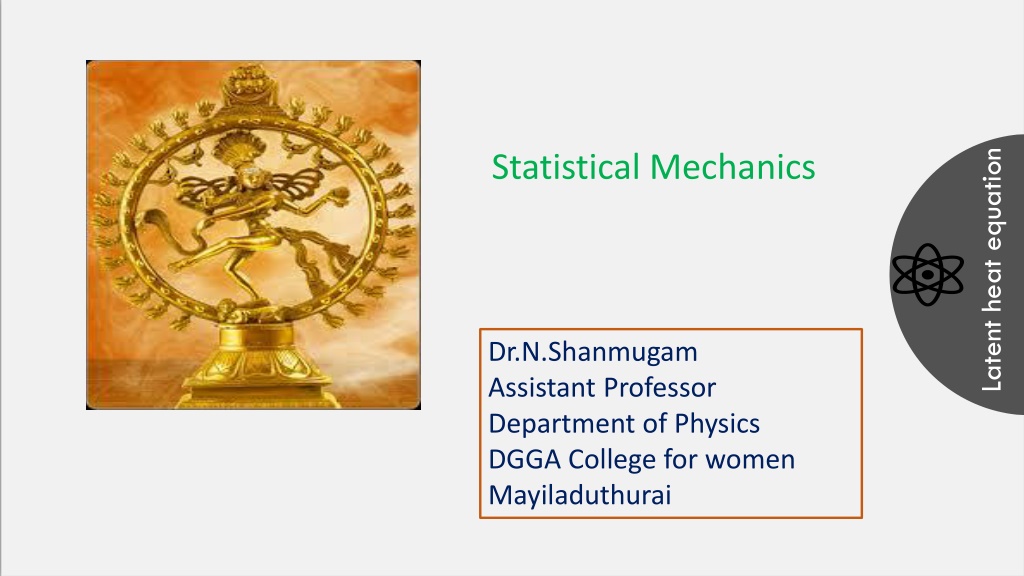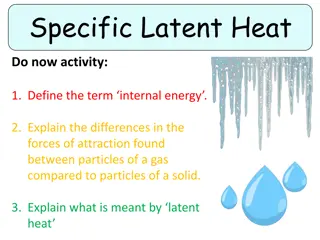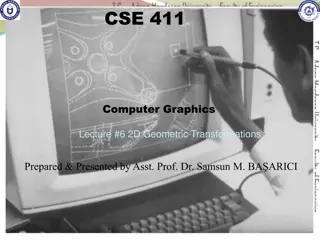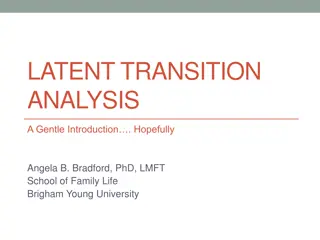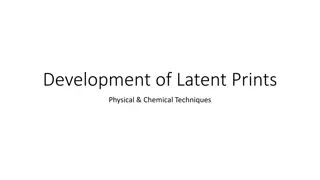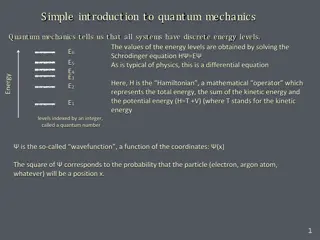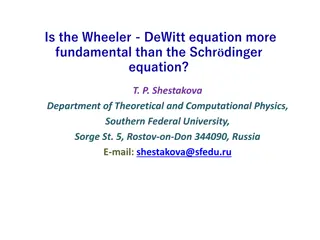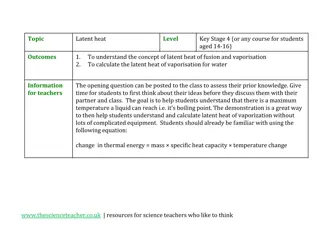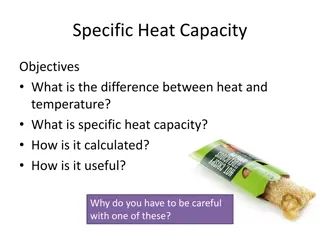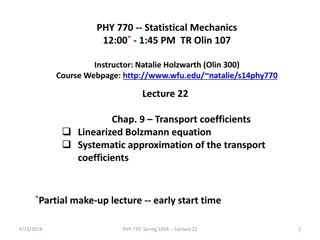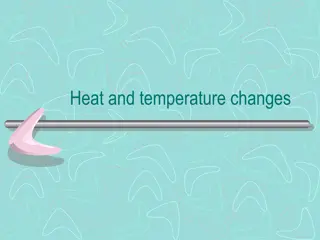Understanding Phase Transformations and Latent Heat Equation in Statistical Mechanics
In this informative piece by Dr. N. Shanmugam, Assistant Professor at DGGA College for Women, Mayiladuthurai, the concept of phase transformations in substances as they change states with temperature variations is explored. The latent heat equation is discussed along with definitions of fusion, vaporization, freezing, condensation, sublimation, and deposition processes. The significance of boiling point, melting point, latent heat of fusion, and latent heat of vaporization is highlighted. The role of enthalpy in endothermic and exothermic processes is explained, along with insights into Gibbs free energy governing the spontaneity of phase changes like melting ice.
Download Presentation

Please find below an Image/Link to download the presentation.
The content on the website is provided AS IS for your information and personal use only. It may not be sold, licensed, or shared on other websites without obtaining consent from the author. Download presentation by click this link. If you encounter any issues during the download, it is possible that the publisher has removed the file from their server.
E N D
Presentation Transcript
Latent heat equation Statistical Mechanics Dr.N.Shanmugam Assistant Professor Department of Physics DGGA College for women Mayiladuthurai
Phase Transformation ?????? ????? ?????? ???????? ???????????? ?????? ?????? ???????????? ??????????? ????? ?????? ??????????
At low temperatures, most of the substances are in the solid state. As the temperature increases, they become liquid. At high temperatures, they become gaseous. The process of a solid becoming a liquid is called fusion or melting. The process of a liquid becoming a gas is called vaporization. The process of a liquid becoming a solid is called freezing. The process of a gas becoming a liquid is called condensation. The process of a solid becoming a gas is called sublimation. The process of a gas becoming a solid is called deposition. Phase Transformation
The temperature of a liquid at which a liquid changes into vapour is called the boiling point. Phase Transformation The temperature at which a solid is converted into a liquid is called the melting point. The heat energy required to convert a solid into a liquid without a change of temperature is called Latent heat of fusion. The heat energy required to convert a liquid into vapour without a change of temperature is called Latent heat of vaporization.
During an endothermic process the material body absorbs heat energy, whereas, in an exothermic process, heat energy is emitted. Phase Transformation The heat content of the system at constant pressure is called enthalpy (h). h = U + PV If the process is endothermic, the enthalpy value gets increased, whereas, in an exothermic process the value decreases. h = Positive (endo thermic) h = Negative (exo thermic)
Why is melting ice a spontaneous process at temperatures above the freezing point? Phase Transformation Why is freezing of ice spontaneous process at temperatures below the freezing point? The change in the Gibbs free energy decides the nature of a process. If G = 1, the process is equilibrium. G < 1, the process is spontaneous. G > 1, the process is non spontaneous.
The conversion of ice into water is an endo thermic process. During an endothermic process the enthalpy increases ( H = Positive). Phase Transformation Furthermore, the entropy value of ice is lesser than that of water. This is because in solid (ICE) the molecules are arranged in the ordered procedure. Whereas, in liquids, the molecules are in the irregular state. High entropy water Low entropy solid
The Gibbs free energy is expressed in terms of enthalpy, temperature, and entropy. G = h TS Phase Transformation The change in Gibbs free energy is G = dh Tds - SdT (1) The conversion of ice into water takes place isothermally. This means that the phase change (solid to liquid ) takes place at constant temperature (dT = 0). Therefore, G = dh - Tds (2) At a temperature above the freezing point, ice melts spontaneously. Therefore, the value of G <1 .(3)
In the equation (2), the values of dh and dS are positive. In order to make G as a negative one, the quantity Tds should be greater than the value of dh (Tds >dh ). If the temperature of ice is above the freezing point, the quantity Tds is more which makes the value of G as negative. Phase Transformation At a temperature below the freezing point, the heat energy is emitted from the system(exo thermic) and then the value of enthalpy is negative (dh = -ve). During the freezing process, the entropy decreases. Therefore, the value of change in entropy is negative (ds = -ve ).
If the temperature of water is below the freezing point, the freezing process is spontaneous and then the value of G is negative. Phase Transformation Now the equation (2) becomes G = - dh - (- Tds) = - dh + Tds .. (3) In equation (3), the value of Tds should be less than that of dh. If the value of Tds is less than dh, the value of G is negative (i.e G < 1).
Clapeyron Latent Heat Equation ?? ??= ? Latent Heat Equation ?(?2 ?1) Let us consider two phases A and B of the same component in equilibrium with each other at constant temperature T and pressure P. A B Let one mole of the substance be transferred from the phase A to the phase B at this equilibrium pressure and temperature. The change in free energy is given by the following equation. ? = ?? ?? = ??????? . (1)
As the system is still in a state of equilibrium, it means that no useful work is obtained from this change ???????= 0 Latent heat equation Therefore G = 0 .. (2) ?? ?? = 0 and ?? = ?? (3) It implies that equal amount of a given substance must have exactly the same free energy in two phases at equilibrium with each other. If the temperature is raised to ? + ??, the pressure must be increased to ? + ??. For this change, molar free energies in the two phases become ??+ ??? ??? ??+ ???, respectively.
Again the system is in equilibrium ??+ ??? = ??+ ??? .. (4) Latent heat equation subtracting equation (4) from equation (3), we get ??? = ??? .. (5) As for this phase change, the work done is only due to the change in volume, the change in energies, ??? ??? ???,may be calculated using the equation G = h TS G = U + PV TS dG = dU + PdV +VdP TdS SdT dG = ?? + VdP Tds SdT dG = Tds + VdP TdS SdT ( ?? dG = VdP SdT ?? = ??? ??? ??? = ???? ??dT (6) ?= ?? ) ??? = ???? ??dT ...(7)
From the equations (5), (6), and (7), we get ?? ?? ?? ?? = ???? ???? Latent heat equation ?? ???? = ?? ???? ?? ?? = ?? ?? ?? ?? As ?? ??? ?? represent the molar volumes of the pure substance in two phases A and B, respectively. Then ?? ?? represents the change in volume when one mole of the substance passes from the initial phase A to the final phase B. Similarly ?? ?? represents the change in entropy for the same process and it may be put as ?.
?? ?? = ? ?? ?? . (8) From the second law of thermodynamics, the change in entropy is equal to the quantity of heat energy either given to the system or taken away from the system at a particular temperature. Latent heat equation ?? ? ..(9) ? = Here the value of ?? is Latent heat(L) ? = ? ? . (10) From the equations (8), (9), and (10) ?? ??= ? ?(?? ??) . (11)
In equation (11), ?? ??? ??are final and initial volumes of the system, respectively. If we consider ?1??? ?2are initial and final volumes, respectively. The equation (8) can be modified as Latent heat equation ?? ?? = ? ?(?2 ?1) During the solid to liquid transformation, the rise in pressure reduces the melting point of the solid when the volume of the material in the liquid (V2) state is less than that of the volume in the solid (V1) state. If the volume of the substance in the liquid phase is greater than that of the volume in solid phase, the melting point increases.
For substance like ice, which contracts on melting. Therefore, the quantity (?2 ?1)is negative. Due to this reason, the value of ?? ?? is also negative. Pressure &Melting The meaning is that the melting point gets lowered with the increase of pressure. For substance like sulphur which expands on melting. Therefore, the quantity (?2 ?1) is positive. Due to this reason, the value of ?? The meaning is that the melting point gets increased with the increase of pressure. ??is also positive.
When a liquid is converted into a gaseous state, the volume of the gas arrived is always greater than the corresponding volume of the liquid. Pressure & Boiling Therefore, the quantity ?? ??is always positive. With an increase of pressure, the boiling point of a liquid always increases. The above principle is used in pressure cocker. Regelation of Ice : As soon as pressure is released over ice, the melting point again increased and ice freezes again. This phenomenon of re-freezing of ice on release of pressure is known as regelation.
